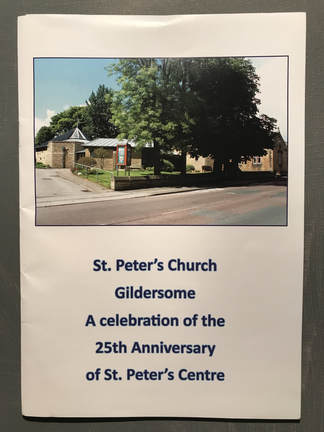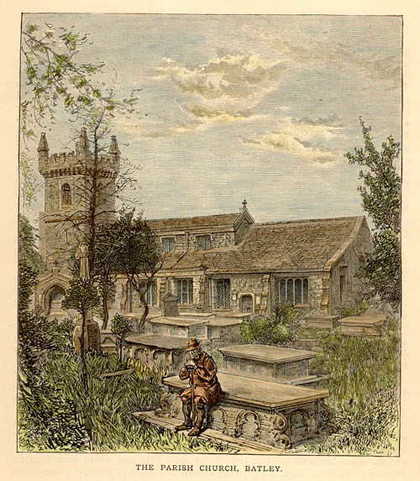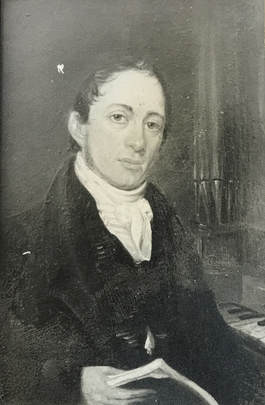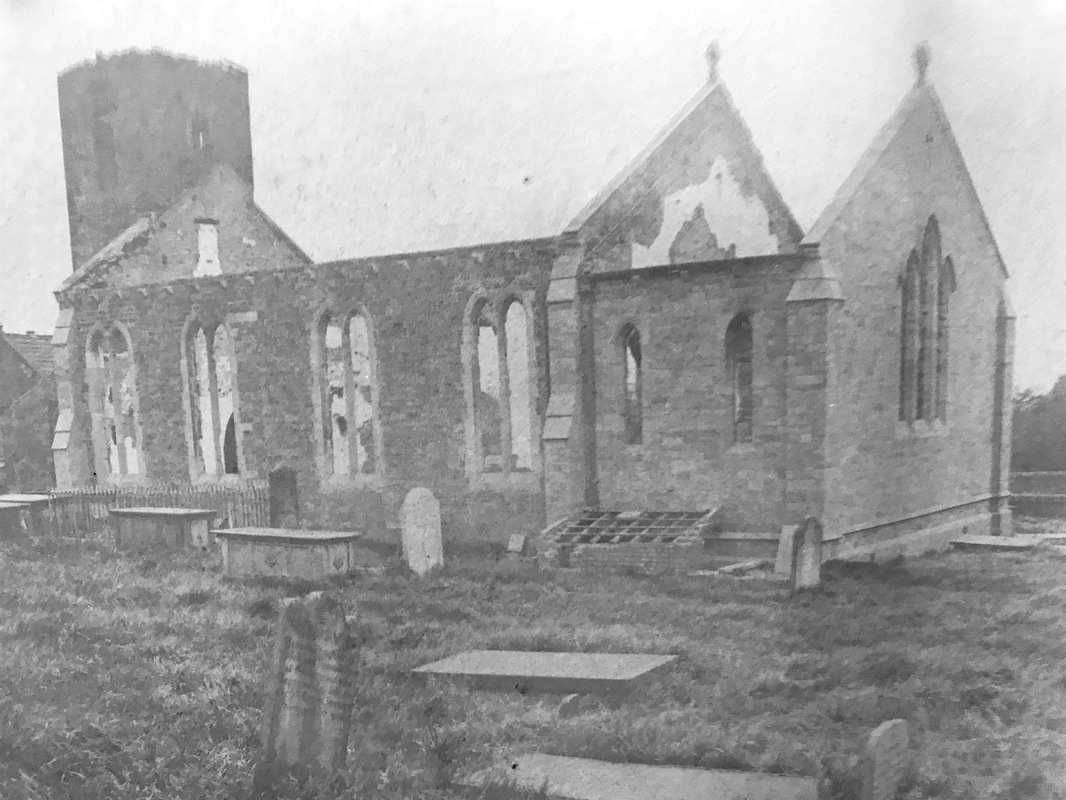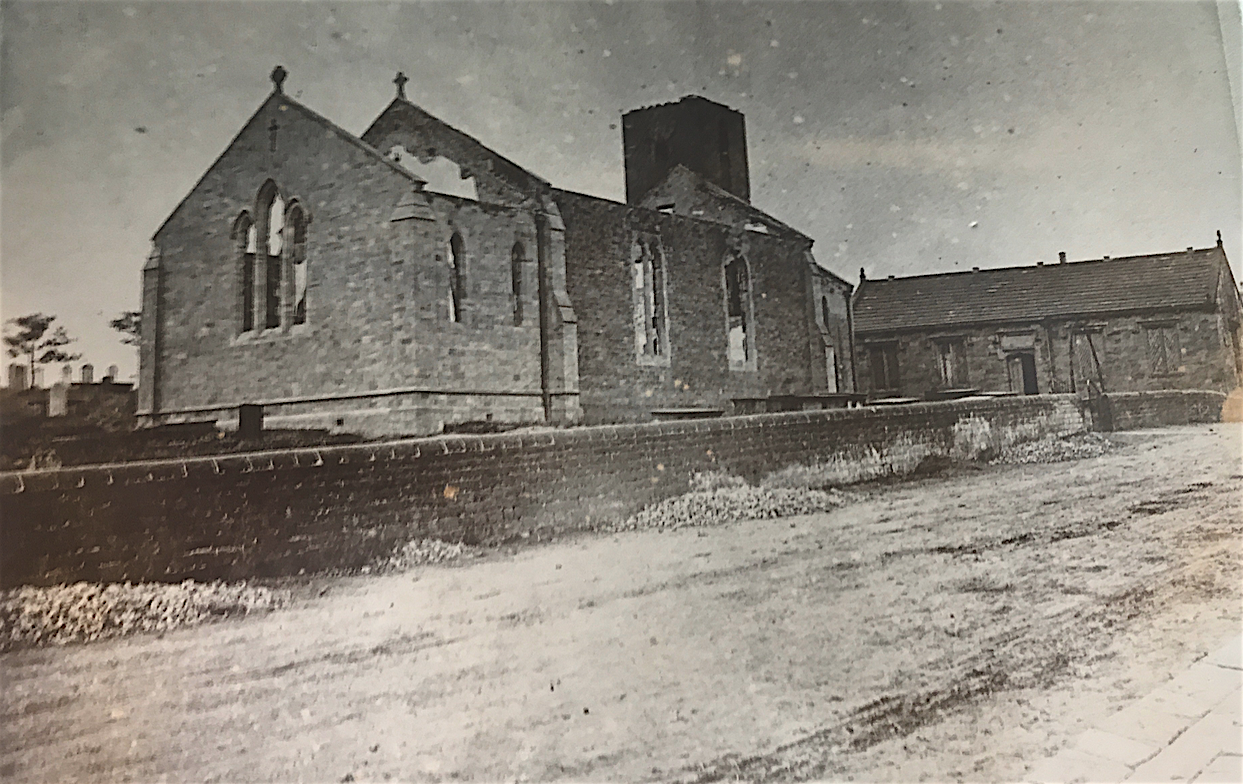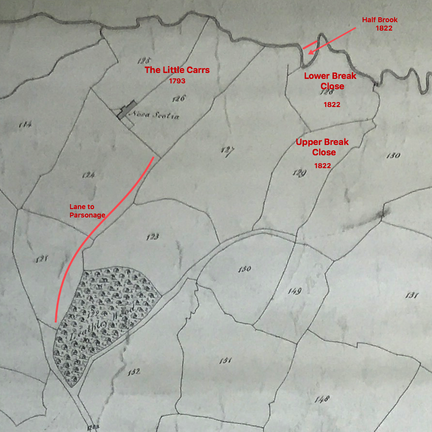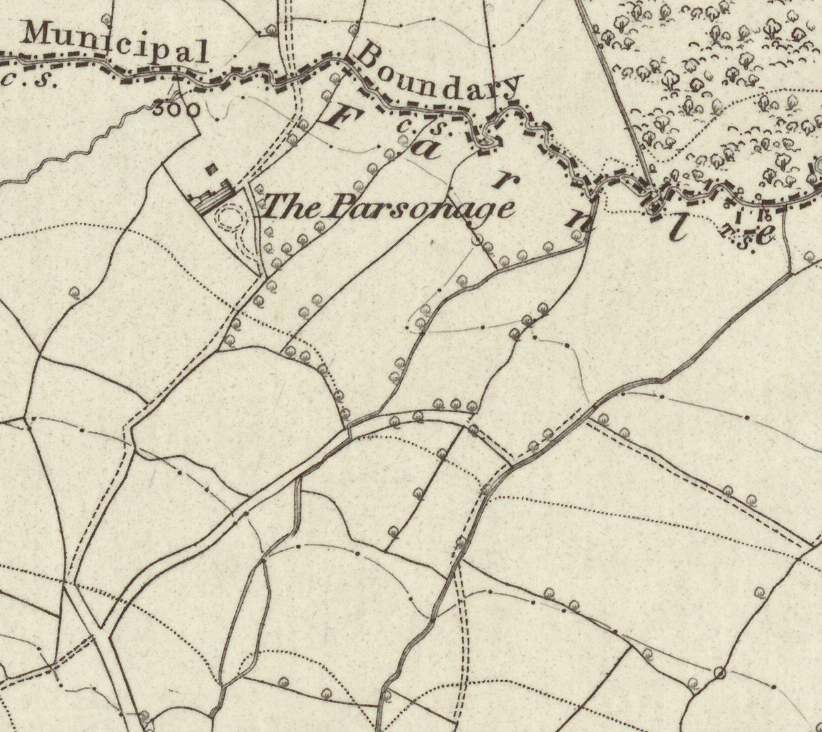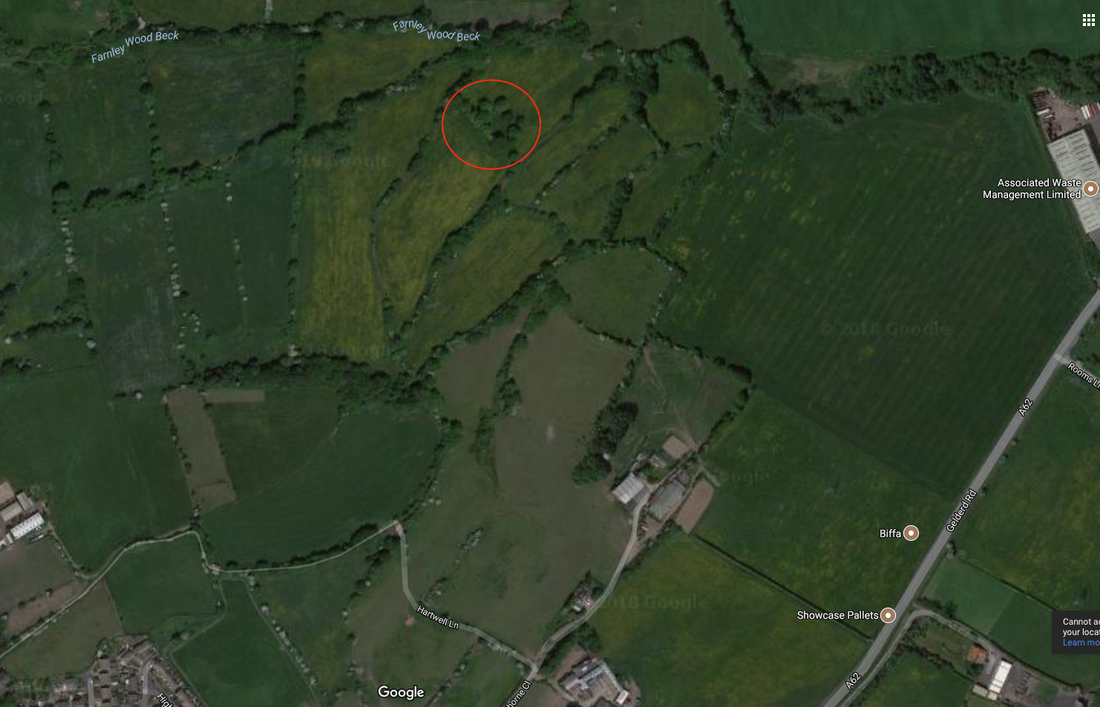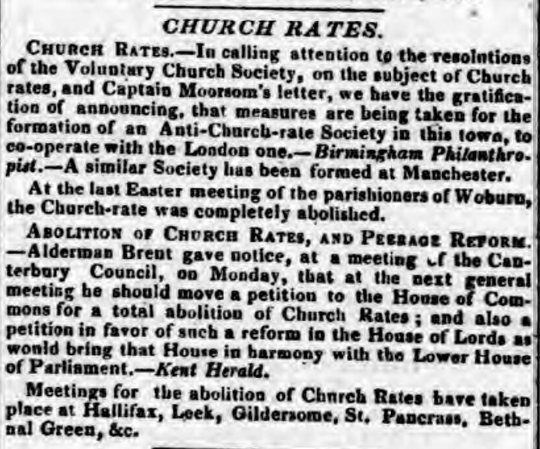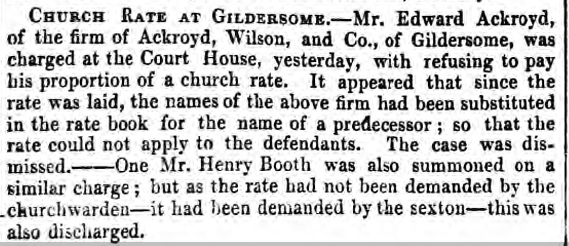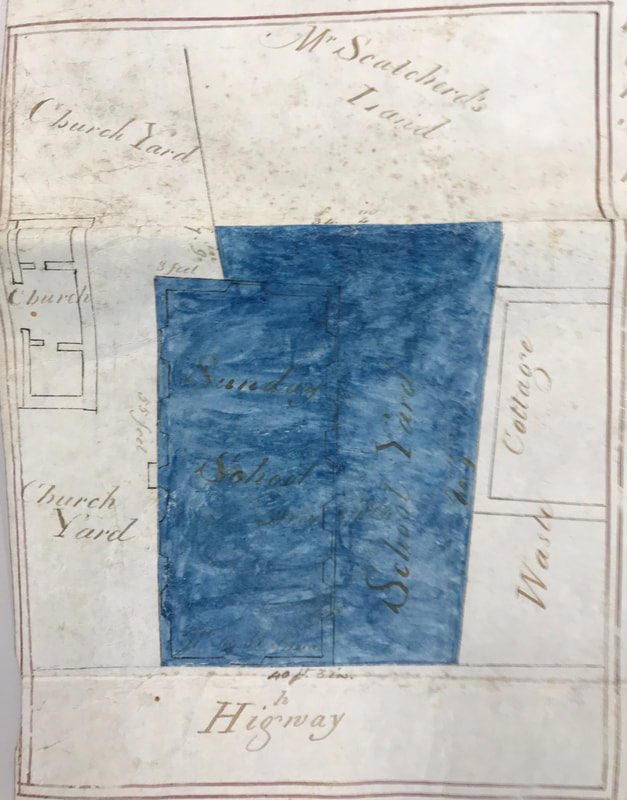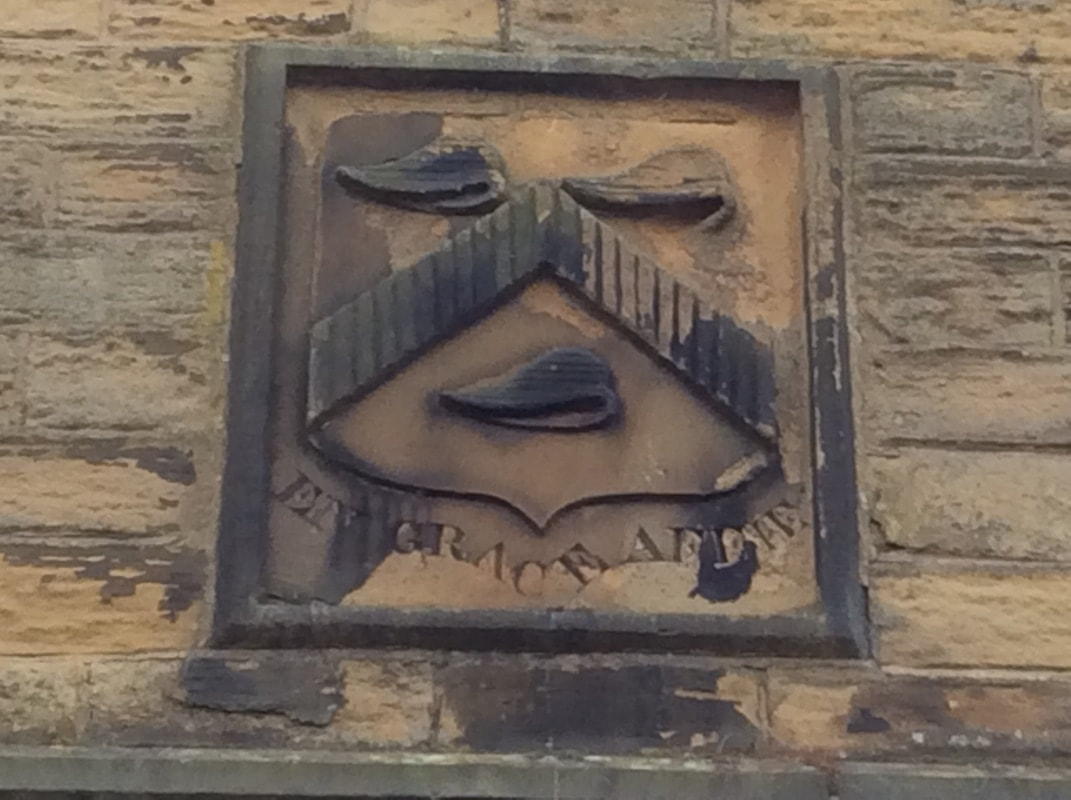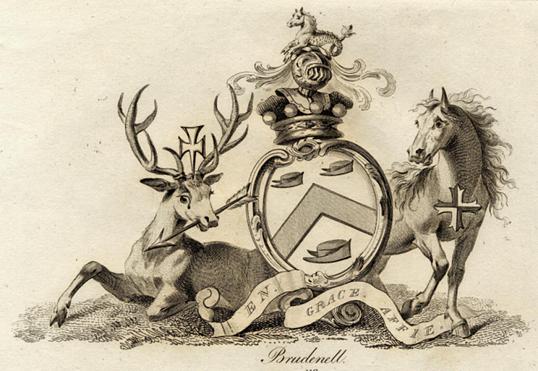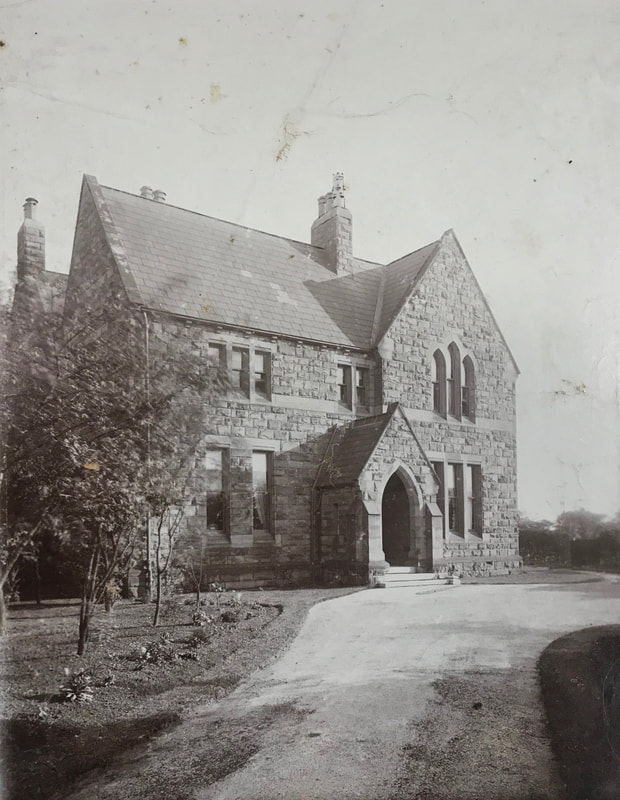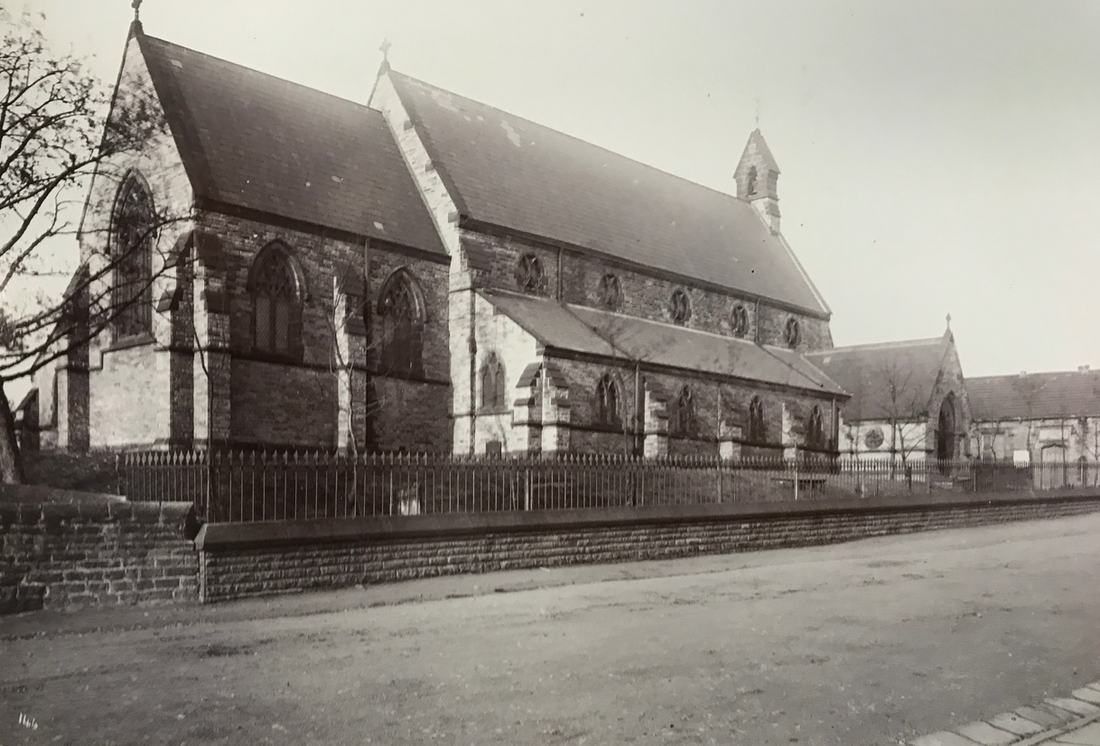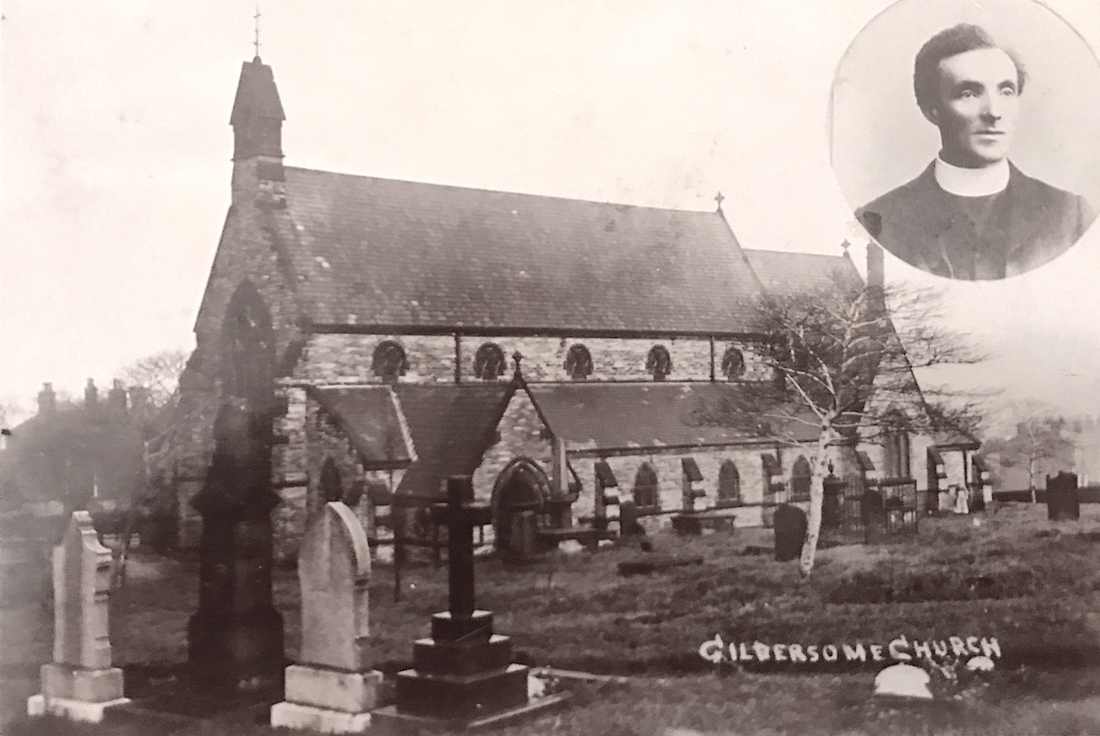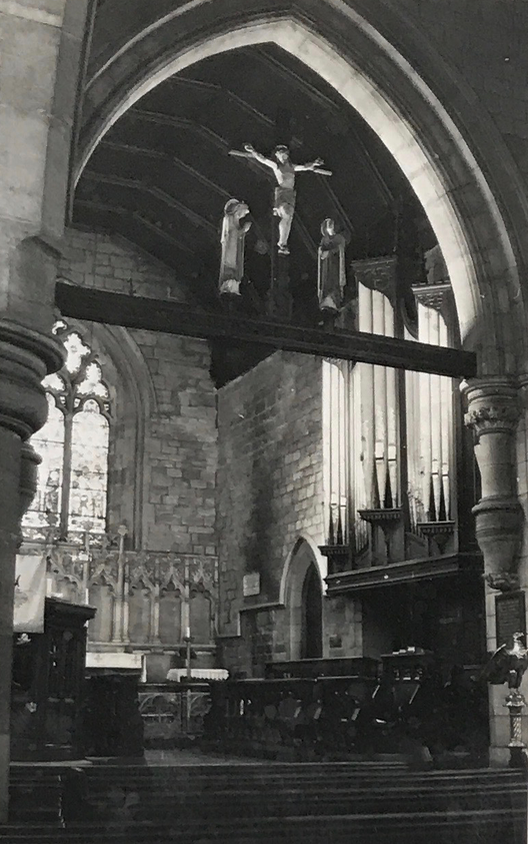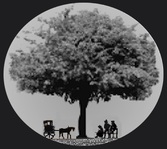St. Peter's Parish Church (the first 100 years)
|
MINISTERS
1780-1787 Samuel Key. 1787-1812 Matthew Sedgwick. 1813-1819 Joseph Wardle. 1819-1867 Andrew Guyse Kinsman, M.A. 1867-1885 Charles Henry Gibson, M.A. (became Vicar in 1870) VICARS ** 1886-1889 Henry Bircham, M.A. 1890-1895 Hugh Albert Claxton, M.A. 1895-1906 David Cowling. 1906-1908 Charles Sydney Hawken, B.A. 1908-1911 Sydney Hawthorne. 1911-1915 Claude Hamilton Roe, M.A. 1915- 1919 William Edw. Colville Barrett, M.A. 1919-1925 Frank Hurst, M.Sc. 1925-1939 Frederick Archer, L.Th. 1939-1959 Eric William Winter, L.D. (1942-1945 Richard Hardcastle M.A., Curate in Charge) 1959-1963 Archie Walls, L.Th. 1963-1970 Frank Butterworth, B.A. 1971- 1982 Dennis Barraclough, S.Th. The booklet (right) has recently been produced to celebrate the 25th anniversary of St. Peter's new church centre. It tells the history of the church back to 1774 and more recently the building of the new church in 1992. One can find a copy at St. Peter's
In the early 1100s, King Henry I granted dominion of the ancient parish of Batley to the Nostell Priory, located close to Wakefield. In 1233, a dispute between the Priory and the parish of Leeds over the northern boundary of Batley parish resulted in Batley's northern border being fixed at Farnley Wood Beck running between Farnley Wood and the assart of Gildus (Gildersome). At that time, Gildersome's population was probably less than one hundred. It took almost 650 years for the population to grow to over 3000, with two thirds of the growth occurring in the last 150 years. In 1870, after the death of its curate for life, Gildersome became an independent parish within the Diocese of Ripon.
|
IMPORTANT DATES
1787 The first St Peter's built. 1780 First Incumbent. 1793 Nova Scotia purchased, called the Parsonage. 1796 May 22nd First burial. 1802 23 Acres of Glebe land purchased in Tollerton. 1812 First baptisms recorded. 1822 3 Acres added to Glebe between Harthill & Farnley Beck. 1832 Licensed for marriages. 1834 Value of benefice £104. 1837 Sunday school built. 1840 Cardigan gift of land for school. 1858 13 Feb Parsonage attacked by burglars. 1870 New district formed and constituted a Vicarage 1872 New Vicarage constructed on Street Lane. 1873 Feb. 15th Church destroyed by fire. 1876 Mar. 13 New Church dedicated by Bishop of Ripon. |
Scatcherd and Whitaker are of opinion that the present church was erected in the reign of Henry VI. or about the middle of the 15th century. It is fortunate for us in modern times that our forefathers in erecting ecclesiastical edifices invariably followed the lines of the " style " of Gothic archi tecture then prevailing, and though those styles are not so easily traced in small country churches, there is sufficient in the
|
In the latter half of the eighteenth century, it was noticed that Gildersome's growing population needed its own place of worship. Traveling to and from Batley parish church for every function was a roundtrip journey of eight miles over rutted, pitted and ofttimes muddy roads. by 1774 it was decided that a Chapel of ease be built on the same site as today's St Peter's (Wikipedia defines a chapel of ease as a church building other than the parish church, built within the bounds of a parish for the attendance of those who cannot reach the parish church conveniently). But it was not until Aug 29 1787 that the chapel was complete and the Curacy of Gildersome created. Apparently, most of the construction costs were borne by Mr. Turton of New Hall (Turton Hall) and Mr Sharpe of Sharp's House (behind today's Karen's Pantry).
|
|
Norrison Scatched, in his History of Morley, while commenting on the chronology of the different denominational churches in Gildersome, stated: "---then followed the Churchmen who about 1774 erected a chapel with a front like the face of a stone quarry, and with angles in abundance; one of the ugliest buildings of its kind, perhaps in the kingdom, but once totally lightsome within." The choice of the church site must not have pleased Scatcherd, for at the time he owned property across the road and also abutting the cemetery at the west end of the church. After publication in 1830, he probably received some push back from the good citizens of Gildersome for this footnote was added to a later edition: "Perhaps it may be said, that the side next to the road is the back part--be it so--This is the part I allude to."
|
On the 15th of February, 1873, the entire church building was destroyed by fire, a gas stove was thought to be the cause. Just prior to the fire, costly improvements had been made to the building including a new chancel added to the East end of the building. The following excerpt from an article published in the 14 Mar 1876 edition of the Yorkshire Post gave this description of the original Old Chapel before its renovation:
"Externally the nave consisted of four plain stone walls, without relief or ornament of any kind, and a flat pitched roof. Two windows on the North side, and four on the South, with plain square stone heads and wooden window frames, with squares of glass, gave light to the interior. A mere shed, with a lean to roof against the East wall of the nave, served the purpose of the chancel, and a similar erection at the West end, with the addition of a low ugly squat tower, enclosed a vestry and a staircase to the gallery. Internally a gallery nearly half the width of the nave extended the whole length of the North side, the pulpit was placed half way down the church on the south side, the floor was covered with high inconvenient pews of various dimensions. Communication between the nave and the chancel was obtained through a small semi-circular headed opening in one side of the wall dividing the two" (1)
To my knowledge, no photos of the old chapel exist prior to its destruction but the two photos (below) taken after the fire show the new addition, containing the chancel, at the end opposite the tower. The Old Church School built circa 1837, shown in the photo on the right, was untouched. We'll return to the topic of the 1873 fire later. (2)
"Externally the nave consisted of four plain stone walls, without relief or ornament of any kind, and a flat pitched roof. Two windows on the North side, and four on the South, with plain square stone heads and wooden window frames, with squares of glass, gave light to the interior. A mere shed, with a lean to roof against the East wall of the nave, served the purpose of the chancel, and a similar erection at the West end, with the addition of a low ugly squat tower, enclosed a vestry and a staircase to the gallery. Internally a gallery nearly half the width of the nave extended the whole length of the North side, the pulpit was placed half way down the church on the south side, the floor was covered with high inconvenient pews of various dimensions. Communication between the nave and the chancel was obtained through a small semi-circular headed opening in one side of the wall dividing the two" (1)
To my knowledge, no photos of the old chapel exist prior to its destruction but the two photos (below) taken after the fire show the new addition, containing the chancel, at the end opposite the tower. The Old Church School built circa 1837, shown in the photo on the right, was untouched. We'll return to the topic of the 1873 fire later. (2)
|
The Parsonage
The new chapel began its existence without a resident minister and services were held by various visiting curates. It wasn't until three years later (1780), that Gildersome got its first incumbent, the Rev. Samuel Key. Since there was no official residence available for him, the diocese must have leased a house in town for that purpose. The Rev. Key lasted seven years and was replaced, in 1787, by Rev. Matthew Sedgwick who presumably occupied the same temporary situation as his successor. Gildersome's curate needed his own income and a suitably respectable residence, so the hunt was on for glebe property fit for the purpose. Eventually, land was purchased by the Diocese of Ripon from John Akeroyd in 1793. Situated on the boundary with Farnley, the new glebe consisted of five acres on two plots called the Low Carrs (see 1800 map, right). Occupying the acreage was a two storey dwelling house with the appurtenances necessary for a working farm.(3) The farm had been known as Nova Scotia (probably due to its remoteness) but later was called the Parsonage. A newspaper account described the dwelling house thus: "On the ground floor there was a drawing-room, dining-room, breakfast-room and kitchen; and on the second floor, three bed-rooms, the two end ones opening into the centre one." (4) Over time, the name Nova Scotia faded from memory, though the nickname "novy" is still remembered today. The Rev. Dennis Barraclough in his book, 'The History of the Parish of Gildersome' wrote: "Why this isolated spot was ever chosen as a Vicarage is a mystery, but for over a hundred years* its various occupants trekked to and fro along a mile of rough country road to take services and visit their people." (*actually, there was no vicarage in Gildersome until 1872 and The Parsonage was occupied for approximately 65 years but Barraclough's point is a valid one) Rather than receive a stipend, the incumbent's income was dependant upon the profits from his glebe holdings, he could either work the land himself, which was uncommon, or lease out the fields, in either case he was the recipient of the proceeds. In 1802, twenty three more acres were purchased for the incumbent (Rev. Sedgwick) in Tollerton, North Yorkshire which today is about 10 miles northwest of York on the A19. According to a survey taken in 1936, the 23 acres were divided into two plots, one with rough pasture on Intake Lane and the other, near Huby, was arable land in good condition. At that time, 1936, all 23 acres were let at a value of £30 per acre. (5) |
Above: Ordnance Map 1852, covering approximately the same area as the 1800 map.
Below: Red circle indicates the location of Parsonage, red circle. (Google Satellite View) |
According to the "Records of the Parish of Batley" by Michael Sheard, 1845; pg. 77:
"The first entry of baptisms at Gildersome Chapel is March 3, 1795, and the first burial at the same chapel is May, 22 1796."
In 1819, an indiscretion made while posted to the parish of Shrewsbury resulted in the Reverend Andrew Guyse Kinsman's appointment to the "much smaller responsibility of "Minister in Charge" of the chapel at Gildersome, where he was later confirmed to the somewhat unusual role of Perpetual Curate." (6) Kinsman paid for his mistake with 48 years of faithful service and became one of St. Peter's best loved, and its longest serving minister.
In 1822, the diocese increased the Glebe holdings in Gildersome by adding three more acres to the existing five. The property was divided into two fields called the Upper Break Close, the Lower Break Close (both together were also known as Cobbler's Close) and one small parcel called Half Brook which actually resided on the opposite bank of Farnley Wood Beck. These were separated from the parsonage grounds by a field occupied by Jonas Stead (see maps). (7)
In 1832, His Majesty's Council of Church Commissioners issued an order creating the parishes of Morley and Gildersome which ended their 700 year domination by and affiliation with the ancient parish of Batley. Population growth was cited as the main reason for the separation, as stated in this portion of the order: "Whereas the said Commissioners have made a representation to His Majesty in Council, stating that in the year 1821, when the census was taken in the parish of Batley, in the county and diocese of York, the said parish contained a population of 9162 persons, which has since considerably increased; that there are in the said parish, besides the parish church, two chapels, one in the township of Morley, built by His Majesty's said Commissioners, and one in the township of Gildersome; that the said parish church, with the said two chapels, afford accommodations for 1950 persons, including 524 free seats appropriated for the use of the poor; that the said two chapels have been consecrated and divine service is regularly performed therein........ it appears to them [the Commissioners] to be expedient that the said parish should be divided into ecclesiastical districts" In an ironic twist, the order further stated that "no such division of any parish into distinct parishes shall completely take effect until after the death, resignation, or other avoidance of the existing incumbent of the parish to be divided." Kinsman's appointment as perpetual curate of Gildersome was a lifelong position, and according to the order, the parish division of Gildersome couldn't take effect until after Kinsman's death which occurred in 1867, 35 years after the Council order. In 1870 the change was finally carried out. (8)
A valuation of the benefice was made in 1834 which revealed that the yearly income from all Glebe land (31 acres) received by Rev. Kinsman totalled £104. When averaged, the good Reverend made approximately one and a third pounds per acre. I suspect that nearly all his revenue came from leasing his fields rather than tending or managing the fields himself. (9)
By 1858, The Parsonage had been occupied for 39 years by Rev. Andrew Guyse Kinsmen. It was then that an armed burglary occurred there that gained nationwide attention for its brazen ferocity. The details of the incident are described in another page: “The Recent Daring Burglary at Gildersome Parsonage".
At the age of 73, Andrew Guyse Kinsman was continuing his duties as the curate of Gildersome. According to the 1861 census, Kinsman and most of his family had left the Parsonage and were residing at Yarra House in Gildersome. He died in 1867 at the age of 79 leaving an estate worth £600. In the same census Kinsman's daughter, Louisa, is found living at 'Knovy' (the Parsonage) with her husband, Robert Webster, and their family. (10)
"The first entry of baptisms at Gildersome Chapel is March 3, 1795, and the first burial at the same chapel is May, 22 1796."
In 1819, an indiscretion made while posted to the parish of Shrewsbury resulted in the Reverend Andrew Guyse Kinsman's appointment to the "much smaller responsibility of "Minister in Charge" of the chapel at Gildersome, where he was later confirmed to the somewhat unusual role of Perpetual Curate." (6) Kinsman paid for his mistake with 48 years of faithful service and became one of St. Peter's best loved, and its longest serving minister.
In 1822, the diocese increased the Glebe holdings in Gildersome by adding three more acres to the existing five. The property was divided into two fields called the Upper Break Close, the Lower Break Close (both together were also known as Cobbler's Close) and one small parcel called Half Brook which actually resided on the opposite bank of Farnley Wood Beck. These were separated from the parsonage grounds by a field occupied by Jonas Stead (see maps). (7)
In 1832, His Majesty's Council of Church Commissioners issued an order creating the parishes of Morley and Gildersome which ended their 700 year domination by and affiliation with the ancient parish of Batley. Population growth was cited as the main reason for the separation, as stated in this portion of the order: "Whereas the said Commissioners have made a representation to His Majesty in Council, stating that in the year 1821, when the census was taken in the parish of Batley, in the county and diocese of York, the said parish contained a population of 9162 persons, which has since considerably increased; that there are in the said parish, besides the parish church, two chapels, one in the township of Morley, built by His Majesty's said Commissioners, and one in the township of Gildersome; that the said parish church, with the said two chapels, afford accommodations for 1950 persons, including 524 free seats appropriated for the use of the poor; that the said two chapels have been consecrated and divine service is regularly performed therein........ it appears to them [the Commissioners] to be expedient that the said parish should be divided into ecclesiastical districts" In an ironic twist, the order further stated that "no such division of any parish into distinct parishes shall completely take effect until after the death, resignation, or other avoidance of the existing incumbent of the parish to be divided." Kinsman's appointment as perpetual curate of Gildersome was a lifelong position, and according to the order, the parish division of Gildersome couldn't take effect until after Kinsman's death which occurred in 1867, 35 years after the Council order. In 1870 the change was finally carried out. (8)
A valuation of the benefice was made in 1834 which revealed that the yearly income from all Glebe land (31 acres) received by Rev. Kinsman totalled £104. When averaged, the good Reverend made approximately one and a third pounds per acre. I suspect that nearly all his revenue came from leasing his fields rather than tending or managing the fields himself. (9)
By 1858, The Parsonage had been occupied for 39 years by Rev. Andrew Guyse Kinsmen. It was then that an armed burglary occurred there that gained nationwide attention for its brazen ferocity. The details of the incident are described in another page: “The Recent Daring Burglary at Gildersome Parsonage".
At the age of 73, Andrew Guyse Kinsman was continuing his duties as the curate of Gildersome. According to the 1861 census, Kinsman and most of his family had left the Parsonage and were residing at Yarra House in Gildersome. He died in 1867 at the age of 79 leaving an estate worth £600. In the same census Kinsman's daughter, Louisa, is found living at 'Knovy' (the Parsonage) with her husband, Robert Webster, and their family. (10)
Rate Payers Revolt
In September of 1833, a meeting of churchwardens and parishioners convened in Batley, the main topic on the agenda was setting the yearly amount of the church rate. After that business was concluded, a proposition was put to the body to lay aside £300 for a lawsuit "to compel the people of Gildersome to pay their portion" (of the rate). The reason: the Baptists, Methodists, Quakers and other Presbyterians of Gildersome felt that they had already paid for the upkeep of their own churches so why should they be forced to pay the same again to the Church of England for theirs? It had long been their contention, especially by the Baptists who made up a sizeable and vocal portion of the town's population, that they should be exempt because their own chapels had been officially confirmed as district churches. After a much heated debate, this motion was presented to the attendees: "That, as it is a disputed point whether Gildersome is exempt or not, the consideration of a suit at law be adjourned to this day twelvemonths." The vote carried by a ten to one majority, but by the time the twelvemonths ended, the notion of spending so much to force recalcitrant Gildersome citizens to pay up offered little chance of success, so it was dropped from the meeting's
agenda. (11)
Church rates were set by the churchwardens together with the parishioners, who were duly assembled after proper notice had been posted in the church vestry or the church........The church rate was a personal charge imposed on the occupier of land or of a house in the parish, and, though it was compulsory, much difficulty was found in effectually applying the compulsion. This was especially so in the case of Nonconformists, who had conscientious objections to supporting the Established Church; in Ireland, where the population was mostly Roman Catholic, the grievance was specially felt and resented.
The objections of the Nonconformists were not only on principle. The Church of England received financial support from Parliament, while Nonconformist congregations were entirely dependent on voluntary contributions. They did not want to have to support another parish as well as their own.
Enforcement of the rate was not uniform across the country. Resolutions were passed protesting against the rate, and societies to abolish the rate were formed all over the country. In 1836 at a public meeting in London, a central committee, the Church Rate Abolition Society, was formed to co-ordinate the efforts of local abolitionist
Societies. (12)
For the next 35 years, until banned in 1868, compulsory church rates were a contentious issue throughout Britain with protests and dirty tricks sometimes rising to ridiculous levels on both sides. Gildersome, far from being an exception, was at times in the forefront of the debate and appeared in newspaper accounts throughout the land. To illustrate the point a few of the early incidents are presented:
In that same 1834 Batley meeting, mentioned above, a loud and heated vote taken to set the church rate for the coming year, was inundated by partisan voters from all over the parish. The vote "for" (the rates) carried narrowly despite a large contingent of Gildersome voters, led by James Bilbrough of Park House and Benjamin Gilpin of Cana House, who voted "nay." It was claimed that 300 or 400 voters from Gildersome and Morley were "wheedled out of their votes" when they were prevented from voting. The view from the Church side was that the dissenters were lying, violent and angry. (13)
Another incident, reported nationwide in August of 1836, involved a rate setting meeting in Gildersome which resulted in a twelve month adjournment. Some members in the Church party were so upset that they refused to wind the church clock so as to deprive the inhabitants of the village of its use. (14) About five weeks later, it appears that tensions between the two factions exploded after a break-in at the church brought matters to a head. Around the tenth of October, the women of St Peter's congregation presented the Rev. Kinsman, as a token of respect, with a silk gown which he wore at the next service. Shortly after, "some bitter enemy or enemies" broke into the church and ran off with the gown. I believe the theft was the catalyst that sparked the next, clearly spiteful, meeting a few days later. (15)
During that August meeting, there had been a discussion about making voluntary contributions by many of the more well to do dissenters who wished to lend assistance. Though the proposal was well meaning, the Churchwardens appeared to have used it as a pretext and posted the following "injudicious notice" about town:
"Gildersome, Oct. 16th, 1836 - Notice is hereby given that a town meeting will be held in the Church Vestry, on Thursday the 20th inst., at eleven o'clock in the morning, to determine upon the propriety of a voluntary rate for the use of the Church, and on matters connected herewith."
On the day of the meeting, a midweek morning while many were at work, the Rev. Kinsman called the meeting to order. This amendment to August's resolution of adjournment was proposed by Jeremiah Stead and seconded by Thomas Stephenson:
In September of 1833, a meeting of churchwardens and parishioners convened in Batley, the main topic on the agenda was setting the yearly amount of the church rate. After that business was concluded, a proposition was put to the body to lay aside £300 for a lawsuit "to compel the people of Gildersome to pay their portion" (of the rate). The reason: the Baptists, Methodists, Quakers and other Presbyterians of Gildersome felt that they had already paid for the upkeep of their own churches so why should they be forced to pay the same again to the Church of England for theirs? It had long been their contention, especially by the Baptists who made up a sizeable and vocal portion of the town's population, that they should be exempt because their own chapels had been officially confirmed as district churches. After a much heated debate, this motion was presented to the attendees: "That, as it is a disputed point whether Gildersome is exempt or not, the consideration of a suit at law be adjourned to this day twelvemonths." The vote carried by a ten to one majority, but by the time the twelvemonths ended, the notion of spending so much to force recalcitrant Gildersome citizens to pay up offered little chance of success, so it was dropped from the meeting's
agenda. (11)
Church rates were set by the churchwardens together with the parishioners, who were duly assembled after proper notice had been posted in the church vestry or the church........The church rate was a personal charge imposed on the occupier of land or of a house in the parish, and, though it was compulsory, much difficulty was found in effectually applying the compulsion. This was especially so in the case of Nonconformists, who had conscientious objections to supporting the Established Church; in Ireland, where the population was mostly Roman Catholic, the grievance was specially felt and resented.
The objections of the Nonconformists were not only on principle. The Church of England received financial support from Parliament, while Nonconformist congregations were entirely dependent on voluntary contributions. They did not want to have to support another parish as well as their own.
Enforcement of the rate was not uniform across the country. Resolutions were passed protesting against the rate, and societies to abolish the rate were formed all over the country. In 1836 at a public meeting in London, a central committee, the Church Rate Abolition Society, was formed to co-ordinate the efforts of local abolitionist
Societies. (12)
For the next 35 years, until banned in 1868, compulsory church rates were a contentious issue throughout Britain with protests and dirty tricks sometimes rising to ridiculous levels on both sides. Gildersome, far from being an exception, was at times in the forefront of the debate and appeared in newspaper accounts throughout the land. To illustrate the point a few of the early incidents are presented:
In that same 1834 Batley meeting, mentioned above, a loud and heated vote taken to set the church rate for the coming year, was inundated by partisan voters from all over the parish. The vote "for" (the rates) carried narrowly despite a large contingent of Gildersome voters, led by James Bilbrough of Park House and Benjamin Gilpin of Cana House, who voted "nay." It was claimed that 300 or 400 voters from Gildersome and Morley were "wheedled out of their votes" when they were prevented from voting. The view from the Church side was that the dissenters were lying, violent and angry. (13)
Another incident, reported nationwide in August of 1836, involved a rate setting meeting in Gildersome which resulted in a twelve month adjournment. Some members in the Church party were so upset that they refused to wind the church clock so as to deprive the inhabitants of the village of its use. (14) About five weeks later, it appears that tensions between the two factions exploded after a break-in at the church brought matters to a head. Around the tenth of October, the women of St Peter's congregation presented the Rev. Kinsman, as a token of respect, with a silk gown which he wore at the next service. Shortly after, "some bitter enemy or enemies" broke into the church and ran off with the gown. I believe the theft was the catalyst that sparked the next, clearly spiteful, meeting a few days later. (15)
During that August meeting, there had been a discussion about making voluntary contributions by many of the more well to do dissenters who wished to lend assistance. Though the proposal was well meaning, the Churchwardens appeared to have used it as a pretext and posted the following "injudicious notice" about town:
"Gildersome, Oct. 16th, 1836 - Notice is hereby given that a town meeting will be held in the Church Vestry, on Thursday the 20th inst., at eleven o'clock in the morning, to determine upon the propriety of a voluntary rate for the use of the Church, and on matters connected herewith."
On the day of the meeting, a midweek morning while many were at work, the Rev. Kinsman called the meeting to order. This amendment to August's resolution of adjournment was proposed by Jeremiah Stead and seconded by Thomas Stephenson:
|
"That, as it is the legal duty of the Churchwardens to provide necessary articles for the Church by a rate on the inhabitants, the sectarian scheme of a voluntary rate is unnecessary : and, in as much as a rate has been refused, the Churchwardens be requested to apply to the Archdeacon and Chancellor of the diocese, for power to make and collect such a rate." (16)
The "voluntaries" were greatly outnumbered and the motion carried. By not allowing discretionary contributions and applying force instead, the churchwarden's actions poisoned an already turbulent situation and in the end, probably didn't receive as much as a farthing. This meeting made the London papers. As can be seen in the newspaper clipping, above right, little Gildersome received nearly the same attention as many larger town around the country. So on it went, the bitter recriminations continuing until the repeal of the compulsory rates in 1868. Frankly, the incidents are too numerous or too embarrassing to mention. My own relation, James Bilbrough, was dragged into court and ordered to pay arrears, but like his and every similar case that came before the magistrates, enforcement lacked resolve. It's doubtful whether any of the outstanding rates from Gildersome were ever recovered.
|
The above excerpt illustrates that when a noncompliant church rate payer was brought to court, the charges were dismissed on the slimmest of technicalities.
|
The First Church School
|
On the 24th day of May 1840, an indenture was signed by James Thomas Brudenell, 7th Earl of Cardigan, of the first part and Matthew Stephenson the younger manufacturer, Robert Elam civil engineer, Robert Smith Gentleman, Andrew Guyse Kinsman incumbent, Thomas Stephenson manufacturer and Isaac Mitchell farmer of the second part (all of Gildersome the latter two being Churchwardens). The indenture was the Earl's gift and granted the Church of England title to approximately 2400 square feet of (the Lord's) waste fronting Church Street and abutting the Church yard to the east (see diagram). According to some sources, St. Peter's Sunday school had occupied the space since 1837, if so, it must have been with the approval of Lord Cardigan. I believe the reason for the title change was purely a benevolent gesture on the Earl's part, probably at the urging of Lady Cardigan. Whatever the motive, the Sunday school continually operated for sixty years until in 1897, when a new Church school was erected.
(Top right) The plan, included as part of the 1840 deed, shows the deeded parcel in blue. The school building is actually depicted as existing and can be made out in the left portion of the blue area. A rough floor plan of the Church tower can be seen on the left edge. The Brudenell crest (middle and bottom right) consists of a white shield, a red chevron and three blue pointed caps. The motto "En Grace Affie" translates as "Trust in Grace" Gildersome's St. Peter's Sunday school (sometimes called the National School) was the product of two social movements that originated in the latter part of the eighteenth century, education of the poor and education for apprentices. Eventually these ideas coalesced into the Sunday school movement championed by Robert Raikes. By 1831, Sunday schools in Great Britain were teaching weekly 1,250,000 children, approximately 25 percent of the population. (17) |
The Vicarage
|
After the robbery at the Parsonage, Rev. Kinsman and his family removed to Yarra House, meant as a temporary measure, situated between Beulah Terrace and Halstead House on the south side of Branch Ave. Evidently the Diocese deemed the Parsonage as unsafe due to its isolated location. Kinsman died in 1867 and apparently most of his family vacated Gildersome. When his successor, Charles Henry Gibson, came to town, far from enjoying the well appointed Yarra House, the Diocese lodged him and his wife in the humble environs of Beulah Terrace with coal miners and mill workers. (18) Again this was a temporary situation and the solution was not long in coming. In 1870, the township of Gildersome was declared a separate Parish and the Rev Gibson was elevated to Vicar. The new Vicar had to have a residence so in 1872, using a combination of funding from the Church and local donations, the Vicarage was constructed on Street Lane. Gildersome's first Vicar, the Rev. Gibson, kept his post until 1885. (19)
|
The Church Fire
There's no better account than this 17th of February 1873 article from the Leeds Mercury:
"DESTRUCTION OF GILDERSOME PARISH CHURCH BY FIRE.
The parish church of Gildersome, a village about five miles from Leeds, has been entirely destroyed by fire. In the early hours of Saturday morning several of the residents perceived a smell like that of burning wood, but it was faint and did not excite such apprehensions as to disturb their usual rest, until an alarm was shortly afterwards raised that the church was on fire. This discovery was made about four o'clock by a carter, who was driving from Pudsey. He gave immediate information to Constable Shackleton, who hurried to the vestry, for the purpose of securing the safety of the registers. These valuable books and documents were, however, out of danger, being kept in the parsonage. After satislying his first anxiety, the policeman saw at a glance that the flames had already taken too great a hold upon the body of the church to be subdued. Even had it been otherwise, there were no means within easy reach of extinguishing a large fire; but of course this absence of such appliances need be the less regretted in a case where their use would certainly have been of little or no avail. It was several hours before the fire had spent itself, for it did not die out until everything that would burn had been consumed. Among the first to arrive at the scene was the minister of the parish, the Rev. C. E. Gibson, but he at once saw, as did also those other friends who quickly gathered round that it was hopeless to save anything from what had long been their place o [sic] worship. When one of our reporters saw the place on Saturday forenoon the church was a complete wreck. The roof had fallen in, and nothing remained but the four bare walls, a damaged portion of the tower, and some rubbish which was still smoking and smouldering. The regret naturally felt at the destruction of the church is increased by the fact that it had been reopened only in August last, after improvements which cost about £1,100. This sum had been almost entirely raised, although with some difficulty, among the parishioners. The church itself, which was not insured, is about a century old, and provided accommodation for 400 persons. Among the recent alterations were that of adding a chancel, getting a new organ worth about £200, reseating the church with pitch pine, reflooring some portions of it, fitting up a new pulpit, and also a stained glass memorial window, the gift of Mrs. Stephenson and family. It is a rather fortunate circumstance that a new altar rail, promised by Mr. Ward, of Churwell, had yet been put in its place, and may therefore be available for the new church which will doubtless be built in place of the one that has been so suddenly destroyed. An encouraging commencement has already been made with the fund for its erection, Mr. W. J. Armitage, of Farnley, having kindly promised a contribution of £250. Other friends who visited the scene of the disaster on Saturday and yesterday also expressed willingness to give practical proof of their sympathy with the minister and parishioners of Gilderseome in their misfortune.
The cause of the fire is not known, and is not now likely to be discovered with any degree of certainty; but the supposition seems to be that it originated with a gas stove which had been used to prevent the new organ becoming damp."
There's no better account than this 17th of February 1873 article from the Leeds Mercury:
"DESTRUCTION OF GILDERSOME PARISH CHURCH BY FIRE.
The parish church of Gildersome, a village about five miles from Leeds, has been entirely destroyed by fire. In the early hours of Saturday morning several of the residents perceived a smell like that of burning wood, but it was faint and did not excite such apprehensions as to disturb their usual rest, until an alarm was shortly afterwards raised that the church was on fire. This discovery was made about four o'clock by a carter, who was driving from Pudsey. He gave immediate information to Constable Shackleton, who hurried to the vestry, for the purpose of securing the safety of the registers. These valuable books and documents were, however, out of danger, being kept in the parsonage. After satislying his first anxiety, the policeman saw at a glance that the flames had already taken too great a hold upon the body of the church to be subdued. Even had it been otherwise, there were no means within easy reach of extinguishing a large fire; but of course this absence of such appliances need be the less regretted in a case where their use would certainly have been of little or no avail. It was several hours before the fire had spent itself, for it did not die out until everything that would burn had been consumed. Among the first to arrive at the scene was the minister of the parish, the Rev. C. E. Gibson, but he at once saw, as did also those other friends who quickly gathered round that it was hopeless to save anything from what had long been their place o [sic] worship. When one of our reporters saw the place on Saturday forenoon the church was a complete wreck. The roof had fallen in, and nothing remained but the four bare walls, a damaged portion of the tower, and some rubbish which was still smoking and smouldering. The regret naturally felt at the destruction of the church is increased by the fact that it had been reopened only in August last, after improvements which cost about £1,100. This sum had been almost entirely raised, although with some difficulty, among the parishioners. The church itself, which was not insured, is about a century old, and provided accommodation for 400 persons. Among the recent alterations were that of adding a chancel, getting a new organ worth about £200, reseating the church with pitch pine, reflooring some portions of it, fitting up a new pulpit, and also a stained glass memorial window, the gift of Mrs. Stephenson and family. It is a rather fortunate circumstance that a new altar rail, promised by Mr. Ward, of Churwell, had yet been put in its place, and may therefore be available for the new church which will doubtless be built in place of the one that has been so suddenly destroyed. An encouraging commencement has already been made with the fund for its erection, Mr. W. J. Armitage, of Farnley, having kindly promised a contribution of £250. Other friends who visited the scene of the disaster on Saturday and yesterday also expressed willingness to give practical proof of their sympathy with the minister and parishioners of Gilderseome in their misfortune.
The cause of the fire is not known, and is not now likely to be discovered with any degree of certainty; but the supposition seems to be that it originated with a gas stove which had been used to prevent the new organ becoming damp."
The Second Church
"CHURCH CONSECRATION AT GILDERSOME. (The Yorkshire Post 14 Mar 1876)
|
On the mornmg of the 15th of February, 1873, Peter’s Church, was totally destroyed by fire. Erected a little over a century before by means of the Sharp family, the ancestors of the present of Vicar of Horbury. .........(description of the old church here, covered above)........... No time was lost In taking measures for the erection a new church in place of the old. On the day of the fire Mr W. J. Armitage, of Farnley, visited Gildersome, and headed a subscription-list by a gift of £250, and on the following day a not despicable sum was dropped into boxes, which had been affixed in the churchyard, by persons who had gone to visit the ruins. Further encouraged by the assistance of members of the congregation and friends at a distance, active steps were taken by the Rev. C. H. Gibson, the vicar, and the Building Committee, which resulted in the commencement of an entirely new edifice in 1874, it being deemed necessary, to ensure safety, to pull down the old walls. The corner-stone of the new church was laid on the 19th of August, 1874, by Mr. Thos. Stephenson, who was liberal contributor towards defraying the cost of the improvements carried out in 1871.
Right top: 2nd St. Peter's as seen from Church St. Bottom: The view as seen from the cemetery. |
The new church is now complete, and yesterday was consecrated by the Lord Bishop of Ripon. Designed by Messrs Adams & Kelly, architects, Leeds, who have given their services gratuitously, a handsome and spacious structure in the decorated Gothic style, has risen on the site of the old church, which in spite of recent renovation was unsightly and entirely devoid of architectural beauty. The building comprises a clerestoried nave, with north and south aisles and chancel. On the south side of the chancel is an organ chamber and vestry, beneath the latter being the heating chamber. The chancel is divided from the nave by a bold moulded chrucal [sic] (appears to be a typo as the arch in question is of gothic style) arch in two orders, the inner order resting upon corbel shafts, having moulded and carved caps and corbels. There are entrance porches on the north and south sides, and a separate entrance for the vestry. The roof Is open-timbered, with framed rafters; the floors are laid with tiles in geometric patterns; and the seats are open benches, with solid ends. The pulpit, font, communion table, and lectern are the gifts of private individuals. The church is built of stone, and will accommodate between 400 and 500 persons, the total cost being £4100. It is hoped at a future time a tower spire will be erected.
|
Below, the chancel and arch mentioned in the paragraph above. (20)
|
Though the weather yesterday was most inclement, there was a large gathering at the consecration ceremony, the church being filled in every part. There was the usual procession into church of the bishop, clergy, churchwardens, and choristers. The sermon was preached by the Bishop, who took for text Job xxxiii., chap., 27 and 28 v.—“He looketh upon men, and if any say, I have sinned, and perverted that which was right, and it profiteth me not; He will deliver his soul from going into the pit, and his life shall see the light.” At the conclusion of the sermon, his lordship said : Some years ago you met with what appeared at the time a great calamity. Sympathy was felt for you, I think I may almost say, in every parish of the diocese. A church upon which you had spent a considerable sum of money for its restoration was burnt to the ground by fire. Who could fail to sympathise with parishioners who, at a considerable cost, had done all in their power to renovate their parish church, and who, so to speak, found all their labour in vain by the disaster which resulted, through fire? And yet God wonderfully brings good out of evil, and I think that those who look upon this beautiful structure in which we are assembled can hardly fail to admit that good has been done in this particular case. For that church, which you renovated, would not for a moment compare with this spacious and beautiful building, in which we are now assembled; so that had it not been for the fire destroying the old Parish Church, you would not have had this new building, which is now consecrated to the service of Almighty God,
|
which will form a place of public worship for the men of this generation, and not only for those, but which will be handed down, we trust, from generation to generation, for ages yet to come. This church has been erected at a very considerable cost. I understand there is still a debt on the building. There is nothing unusual in this, for it has very rarely been my lot to consecrate a church upon which there was no debt. But there is a debt to be met on this church of about £600. You have to face that difficulty; you have still to draw upon your resources for the liquidation of this debt; but you have great encouragement to do so, for I am told that through the liberality of one or two amongst you £250 of the debt will bo immediately discharged, if only the parishioners will rise in their liberality to meet the remainder. I would put this before you, and earnestly ask you to do your very best without delay to wipe off the remaining liabilities. Depend upon it, you will be no losers by what you give for the glory of God and the promotion of His honour. Money so spent is well spent is the best kind of investment, in that it will glorify God and tend to the salvation of souls and the extension of the Redeemer’s kingdom. It will return to you in spiritual blessings, which no money can purchase and arithmetic compute.
Amongst the clergy present were the Rev, C. H. Gibson, vicar of Gildersome; Rev. J. Earnshaw, Birkenshaw; Rev. J, Freeman, West Ardsley, Rev. C. Foster, Dudley Hill; and Rev. J. Crooks, curate, Morley, After the service, luncheon was served the schoolroom."
Amongst the clergy present were the Rev, C. H. Gibson, vicar of Gildersome; Rev. J. Earnshaw, Birkenshaw; Rev. J, Freeman, West Ardsley, Rev. C. Foster, Dudley Hill; and Rev. J. Crooks, curate, Morley, After the service, luncheon was served the schoolroom."
Subscriptions for the alteration of the Chancel and improvements to the first Church 1871-1872:
note: values in Pounds unless marked.
note: values in Pounds unless marked.
|
Mr Matthew Stephenson
Mr Thomas do Mr Joseph do Misses do Mr Robert Holliday Mr John Helliwell Mr Thomas Ogden Messrs Hudson Miss Lavinia Holliday Mr Thomas do Mr Cyrus do Mrs Stanhope Miss Webster Earl of Dartmouth Mrs John White Rev. C.H. Gibson Dr J.B. Clarke Mr Joseph Wade Mr Matthew Field Mr Benj Glover (Grocer) Mr William Holliday Mr Thomas Holdsworth Mrs Sharp Mr Roland Leathley Mr Robert do Mr Thomas Bailey Mrs Eddison Mr Smith (New Inn) Mr Samuel Peel Mr William Brooke Miss Lavinia Holliday (card) Miss Julia Holliday (card) Miss Margaret Ogden (card) Mr J. Westerman (card) Miss Emma Sharp (card) Miss Elizabeth do Mr Trippleton Supplemental Subscriptions: (for Memorial Window): Mr John Helliwell Mr Joseph Stephenson Mr Stephenson’s Family (for Re-Pewing): Mr Thomas Stephenson Mr Matthew do Misses Stephenson (for New Pulpit): Messrs Stephenson (for Wall Supports for Pews): Messrs Stephenson (for Organ Fund): Mr Robert Holliday Mr John Dixon SUMMARY :
Total Subscriptions £ 1073 13s For Boarding Roof £ 39 17s Sewing Committee £ 43 Other Collections £ 58 5s GRAND TOTAL £1153 14s |
100
100 12 10s 30 50 25 10 10 7 5 5 5 5 5 4 2 2 2s 1 1 1 1 1 10s 10s 10s 10s 2s 10s 10s 2s 6d 3 2 4s 2 10s 4s 1d 12s 15s 1 10 10 105 35 35 153 16 10 35 10s Cont..... |
Cont........
Windows on the South Side of the Church Mr Robert Holliday Mr John Helliwell Mr J. Greenwood (Leeds) do Sons do Daughters Mr George Thackery Mr John Beaumont Miss do Mr Cyrus Holliday MrHenry do Dr Clarke Mr Jonathan Senior Mr Enoch Hardwick Mrs Stanhope Mr Benj Glover (Grocer) Mr Benj Glover (Street) Mrs Clapham Miss Otter Rev C.H. Gibson Mr William Holliday Mr Alfred Booth Mr Thomas Wilson Mr Dan do Mr James Firth Mr John Hartley Mr Joseph Mitchell Mr James Dawson Mrs Mary do Mr Jim Stead Mr Walklett Mr John Booth Mr Smith (New Inn) Mr Robert Leathley Mr Robert Webster Mr Mathers (Rodley) Messrs Thom & G Bedford Mr Richard Booth Mr C Ellison Mr William Lister Mr Thom Holdsworth A Friend Mr Thomas Bedford Mr John Helliwell Mr Robert Holliday Mr Joseph Wade Mr Benj Glover Rev C.H. Gibson (Boarding Roof Inside Church): Mr T Stephenson Mr M do Mr Robert Holliday Sewing Committee Collections: Aug 3rd Aug 4th Morning do Evening Aug 18th Morning do Evening Sewing Committee Mrs Ward's Servant Girl |
30 10 10 3 2 1 1 1 5 5 5 2 10 2 1 1 1 1 1 1 1 1 1 1 1 10s 1 1 1 1 1 1 1 2s 10s 15 10s 1 5s 1 2s 6d 40 10 25 2 1s 1 2 13 13 13 41 18 14 13 4 15s 2 14s 2 12s |
Subscriptions to the Vicarage Fund at Gildersome April 1872:
note: values in Pounds unless marked.
note: values in Pounds unless marked.
|
Ripon Diocesan Society
Mr Thomas Stephenson Mr Matthew do Misses do Mr Robert Holliday Messrs W. Akeroyd & Bros Mr John Helliwell Rev. C.H. Gibson Mr James Leathley Messrs Bedford Mr Joseph Stephenson Mr Thomad Ogden Miss Booth Mrs Booth Mr W. Bilbrough Mr D. Gaskell Mr Isaac Beaumont Mr J.M. Gaskell Rev A. Cassells Earl of Dartmouth T. Greenwood Esq. J. W. Armitage Esq. Mr W. Ward Mr J. C. Clarke Mrs Clapham Mrs Haigh Miss Webster E.B.W. Balme Esq. Miss Wheatley |
150
50 50 50 50 50 25 20 20 15 12 10s 10 10 20 10 10 10 10 10 10 10 10 10 10 5 5 5 5 5 Cont... |
Cont..............
S. Scatcherd Esq. J. do Esq. Mrs Clapham's Card Mr James Firth Mr John Booth Mr James Gomersall Mr Thomas Holdsworth Mr Jim Staed Mr B. Glover (Grocer) Mr S. Oddy Mr Thomas Bailey Mr Robert Bailey Mrs Cryer Mrs Scatcherd Mrs Wolfenden Mrs Walker Bank Interest April 30, Paid to the Bank of England to a/c of Ecclesiastical Commissioners in London Commission B. of E. May 14th 1872 Becketts Bank GRAND TOTAL |
5 5 4 8s 6d 2 2s 2 1 1 1 1 1 1s 1 1 1 10 10s 10s 18s 4d 650 4s 45 15s 10d £ 695 19s 10d |
Subscriptions towards the Erection of a New Church Feb. 21st 1873:
note: values in Pounds unless marked.
note: values in Pounds unless marked.
|
Mr J.W. Armitage (Farnley)
Mr Robert Holliday Mr William Ward (Churwell) Mr James Ward Messrs T. & G.T. Bedford Mfr John Helliwell Misses Elam (Ledberg) Mr Dan Wilson Rev C. H. Gibson Mr Benj Glover (Grocer) Mr Jim Stead Dr J. E. Clark Mr John Booth Miss Otter Mrs Clapham Mr J. Oddy Mr John Wade (Birstall) Mr Matthew Field Mr Thomas Trippleton Mr James Firth Mr J. Stunt (rent) Mr W. Chadwick (Batley) Mr Edward Haigh Rev H. W. Parkinson (Morley) Mr James Saville Mr Robert Leathley Mr Samuel Peel Mr William Holliday Messrs Beckett & Co. (Leeds) Mr Grorge Jubb (Batley) Mr Edward Scholes (Morley) Mr John Hartley Mr Isaac Beaumont A Friend (Armley) Collections in Boxes Hough End Church Earl of Dartmouth Rev Canon Heald Mr Abraham Pollard (Ossett) Archdeacon Musgrave Rev JH Brooke (Thornhill) Messrs Sheard & Sons (Batley) Mr Joseph Smith (Gildersome St) Mr Charles Ellison Mr Gray (Calverley) Mr William Mead Mr Ephraim Holliday Mr C. Chadwick Mr Edward Ackroyd Mr C. Hainsworth (Farnley) Mr Schofield (Batley Mr Joseph Newsome (Batley) Mr C. M. Gaskell (Thornes) Mr J. Chadwick (Mirfield) Mr George Gilpin Mr James Gomersall Miss Bailey Miss J. S. Perkin Messrs George Burrows Bros. Mr Mark Darnbrough Dr Sykes (Drighlington) Mrs Naylor Mrs J. G. Hartley Mr Sam Hirst Mr J. Dibb Mr R. Atkinson Mr Dan Stables Misses Beaumont (small sums) Mrs Page (rent) Mr Samuel Scott (Bruntcliffe) Mrs Haigh (Crow Nest) Mrs Horsfall (Wharfdale) Mr Gaythorne Hardy Mrs Wheatley (Mirfield) Miss Ruth Gilpin's Card Miss M.A. Glover's Card Miss Ruth A. Haigh's Card Miss M.A. Saunder's Card Miss Alice Stock's Card Miss E. Lambert's Card Miss Isabella Wait's Card Master Walter Lambert's Card Mr Wright's Card Mr Stead Stewart's Card Miss M. A. White's Card Miss Beaumont's Card Mr Samuel Jubb (Batley) Mr Robert Nichols (Bramley) Mr E. Hemingway (Batley) Mr Thomas Holdsworth Messrs Greenwood (Leeds) Mr John Beaumont (Leeds) Farnley Church, Collection Miss Greenwood (Leeds) Rev, Canon Woodford Mr J. D. Heaton (Leeds) Rev J. Ellison (Sowerby Bridge) Mr S. Botoomley (Shelf) Mr Bedford (Woodhouse) Collecting Boxes Mr E.B.W. Balme Mr Robert Hudson Mr Robert Holliday (for Slates) Mr George Hudson Mr Thomas West Marquis of Ripon Woodchurch Collection Rev H. Bailey (Canterbury) Miss Alice Holiday's Card Mr Holliday Booth's Card Mr Elijah Stocks (Thornhill) Mr Burton Cont............ |
250
250 200 21 100 50 20 15 10 10 5 5 10 2 2s 3 3s 1 1s 5 1 2 2 2s 5 5s 10 10s 1 1s 5 5s 2 5 1 1 1s 100 3 1 1 1s 10 10s 10 8 10s 4 100 20 5 5s 10 10 20 50 3 3s 5 5s 5 30 5 20 10 20 20 5 1 5 10s 10s 10 5 5 10s 1 10s 2s 6d 2s 6d 1 1 6s 2 2s 1 25 10 5 15 1 10s 4s 8s 6d 6s 6d 10s 13s 1d 1s 6d 1 6s 12s 6d 7s 17s 7s 6d 10 10 2 10 150 50 13 8s 6d 5 5 5 1 1s 2 1 10s 15 5 2 15s 10 10s 2 20 9 2 3 7s 6d 2 5s 1 1s 1 |
Cont...
Mr E. Haigh Small Sums Mr Joseph Holdsworth (Farnley) Miss Anne Holliday's Card Ladies Sewing Committee Rev F. T. Armitage F. R. do MD E. do RA Mrs Horsfall Mr James Wilson (Grocer) Miss Nussey Mr Baines (Morley) Mr R. Wheatley Mr Jonathan Senior Mr John Thompson Mr G. Walker Messrs Fernley Bros Mr Roland Leathley Messrs Taylor & Fletcher Mr Robert Hudson (for Old Iron) Mr George Richardson Mr R. Smith Mr S. Farrar Wortley Church Collection Mr J. E. oddy Mr C.F.D. Shafton Rev J. Howman Mr W. H. Thornton Bishop of Ripon Mr Thom Holdsworth & Sons (for Slates) Mr Alfred Brough Mr Ephriam Fox Mr George Walker Mr J. A. Cooke Mr Dan Stephenson Rev Canon Bailey Mr George Fox Miss Middlebrook Mr Enoch Hardwick Mr Edward Almond Rev A. Hudson Mr J. S. Laycock Mr H. Longbottom Mr Oddy Mr Michael Sheard Doctor Holliday (Leeds) Miss Taylor's Card Mr Sykes (Leeds) Mr J. Whitworth Mr J. Hainson Mr J. Potter (Middlesbro') Miss Beaumont's Card Liversedge Church Collection Mr George Jubb (Batley) Mr Hepworth (Morley) Mr Isaac Crowther Mr E. Helliwell A Friend Mr Stockwell (Morley) Mr John Stead (Morley) Mr Wlm. Boardman Mr Rowland Leathely Miss L. do Miss A. M. do Mr J. D. Proctor A Friend William Kay William Hartley Mr John Naylor Mr Jesse Ledger A Friend Mr J. Parker Mr J. Cox Mr T. Birchall 1874.... Mr John Battye (Birstall) Mr George Cradock (Wakefield) Aug 19th: Subscription on the Laying of the Corner Stone...... Messrs R. Holiday and Sons for Spouts............... Mrs Robert Holiday's Sewing Committee............... 1876 March 13 Consecration Services: Morning Collection Evening Collection the 19th Morning Collection Evening Collection TOTAL Total Cost of the Alteration to the Chancel of the Old Church................. Afterwards destroyed by the fire. Cost of the New Vicarage to replace the Old one situated in a very unsuitable position at Nova. Total Cost of New Church.................. (Combined Total) |
1 1s 1 5s 1 2 6 50 17 10s 17 10s 5 5 5 5 5 2 2s 2 2s 1 1s 1 1s 1 1s 1 1s 5 10s 1 1 1 11 8s 6d 5 10 5 1 1s 20 2 2s 1 5 5 10 1 3 5 2 10 10s 2 2s 10 1 25 1 5 2 10 10s 1 2 2 2s 5 3 13s 6d 9 11s 6d 7 10s 1 2s 6d 10s 10s 1 1 10s 1 1s 5s 1s 5s 2s 10s 10s 10s 5s 3d 2s 1s 1s 10 2 2s 29 10s 8d 1 10s 5 58 16s 18 18s 6d 16 14s 10d 9 18s 6 2379 12s 3d £1153 14s 6d £695 10s £2379 12s 3d £4228 12s 3d |
SOURCES:
1] The Yorkshire Post 14 Mar 1876
2] Both photos courtesy of the Morley Observer Photo Archive
3] Gildersome St. Peter's Parish Records WDP26/3/21 - WYAS Wakefield
4] 1858 4/3 Kinsman Case, Leeds Mercury
5] Gildersome St. Peter's Parish Records WDP26/3/7 - WYAS Leeds
6] Morley Family History Group Publication "Cameo" 1999, No. 2 Edition, page 14
7] Gildersome St. Peter's Parish Records WDP26/3/21 - WYAS Wakefield
8] London Gazette 27 Mar 1832
9] "History of Gildersome" 1920, Philip Henry Booth
10] “The Recent Daring Burglary at Gildersome Parsonage" 2018, Andrew Bedford, https://www.gildersome.net/saint-peters.html
11] Leeds Times 07 Sep 1833
12] Wikipedia
13] Leeds Intelligencer Sep 27 1834
14] Bradford Reporter Aug 27 1836
15] Leeds Intelligencer 15 Oct 1836
16] Leeds Intelligencer 22 Oct 1836
17] Wikipedia
18] 1871 UK Census
19] "History of Gildersome" 1920, Philip Henry Booth
20] Morley Observer Photo Archive
1] The Yorkshire Post 14 Mar 1876
2] Both photos courtesy of the Morley Observer Photo Archive
3] Gildersome St. Peter's Parish Records WDP26/3/21 - WYAS Wakefield
4] 1858 4/3 Kinsman Case, Leeds Mercury
5] Gildersome St. Peter's Parish Records WDP26/3/7 - WYAS Leeds
6] Morley Family History Group Publication "Cameo" 1999, No. 2 Edition, page 14
7] Gildersome St. Peter's Parish Records WDP26/3/21 - WYAS Wakefield
8] London Gazette 27 Mar 1832
9] "History of Gildersome" 1920, Philip Henry Booth
10] “The Recent Daring Burglary at Gildersome Parsonage" 2018, Andrew Bedford, https://www.gildersome.net/saint-peters.html
11] Leeds Times 07 Sep 1833
12] Wikipedia
13] Leeds Intelligencer Sep 27 1834
14] Bradford Reporter Aug 27 1836
15] Leeds Intelligencer 15 Oct 1836
16] Leeds Intelligencer 22 Oct 1836
17] Wikipedia
18] 1871 UK Census
19] "History of Gildersome" 1920, Philip Henry Booth
20] Morley Observer Photo Archive

